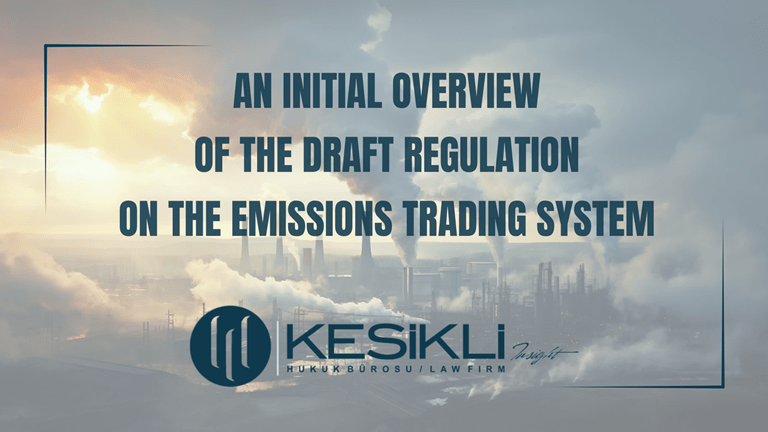What Does the Draft Amendment to the Unlicensed Electricity Generation Regulation Introduce?
The Energy Market Regulatory Authority (“EMRA”) has submitted a new draft amendment to the Regulation on Unlicensed Electricity Generation for public consultation. The proposed changes introduce not only new opportunities for investors, but also certain limitations. It can be stated that the details of these amendments which may directly affect the dynamics of the electricity market are of critical importance, particularly for industrial enterprises, municipalities, and agricultural irrigation cooperatives intending to invest in renewable energy.
New Application Restriction for Transferred Facilities (Article 10/5)
Under the new draft regulation, where a generation facility falling within the scope of Article 5/1-h is transferred, it shall no longer be possible to submit a new application for the consumption facility associated with that generation facility. However, it is understood that this restriction will not apply in cases where the transfer is made to the same natural or legal person.
Assessment from an Investor’s Perspective: This provision may be interpreted as a measure designed to prevent the transfer of application rights. It appears that the objective is to eliminate prior applications that aim to generate indirect profit through capacity allocation without any genuine investment intent. Nevertheless, this change could also be seen as reducing flexibility for investors. Even if a facility is acquired, the prohibition on submitting a new application for the associated consumption facility may act as a limiting factor for the tranferer.
New Priority Criteria in Application Assessment (Articles 14/6 and 14/9)
The draft regulation introduces a revised set of priority criteria to be applied during the technical evaluation of applications. Moving forward, factors such as:
- Whether the generation and consumption facilities are located at the same metering point, and
- The adjusted consumption amount based on previously allocated capacities (Adjusted Consumption Amount – “ACA”),
will play a more prominent role in the assessment process.
According to the new calculation method, any previous capacity allocations associated with a particular consumption facility will reduce the priority score of new applications related to that facility. Additionally, where the consumption facility is used for municipal, industrial, or agricultural irrigation purposes, the connection capacity will be assessed based on twice the installed capacity.
Assessment from an Investor’s Perspective: This new framework aims to promote capacity allocation based on actual consumption needs and to ensure a more equitable ranking of applications. However, investors who have previously shared their allocated capacities may find themselves at a competitive disadvantage in future application rounds.
Application of the Renewable Energy Projects Evaluation and Monitoring System (“YEPDİS”) Process to Biomass and Geothermal Projects (Article 16/1)
The YEPDİS system, previously applicable only to solar and wind energy projects, will now also cover applications related to geothermal and biomass sources, under the supervision of the Directorate General of Energy Affairs (“DGEA”). Furthermore, applicants will be granted the possibility to request site changes or revisions in cases of technical issues such as site overlaps.
Assessment from an Investor’s Perspective: While this extension is likely to enhance transparency and technical compliance within the application process, it should be noted that projects involving biomass and geothermal sources, due to their more complex site requirements, may experience increased administrative burdens as a result of this procedural inclusion.
Sanctions for Facilities Supplying Energy Prior to Acceptance (Article 37/13)
The draft explicitly states that generation facilities supplying energy to the grid without a connection agreement or completing acceptance procedures will be disconnected from the network without prior notice. Additionally, such facilities will be required to provide energy contributions free of charge for 12 months and will be prohibited from submitting new applications for 3 years.
Assessment from an Investor’s Perspective: This provision appears aimed at preventing abuses within the system. However, it also raises the risk of penalizing good-faith investors who may face delays in the acceptance process. Therefore, it is considered critical that the relevant authority conducts procedures within reasonable timeframes.
General Assessment
The draft amendment submitted by EMRA for public consultation appears to aim at establishing a more disciplined, predictable, and technically coherent framework in the field of unlicensed electricity generation. The introduction of concrete criteria for capacity allocation and application ranking is expected to contribute to a more transparent and equitable application process within the sector.
However, certain provisions in the draft may limit investor flexibility. For example, the ban on submitting new applications for the same consumption facility after transferring a generation facility, or the strict sanctions on facilities operating before completing acceptance procedures, could create risks for investors, especially when administrative delays happen.
Moreover, excluding the impact of previous capacity allocations when calculating consumption for priority evaluation may put existing producers at a relative disadvantage in new application rounds. However, this approach appears motivated by the aim to encourage capacity allocation based on actual consumption needs.
The expansion of the technical evaluation process to include geothermal and biomass resources will require applicants to plan their administrative and technical preparations more carefully. In particular, additional steps such as site conflict resolution and the YEPDİS process are expected to create new time and resource demands for more complex projects.
While the draft regulation revises the criteria applicable to unlicensed applications, it has yet to introduce measures ensuring procedural transparency, which are essential for achieving a fully transparent and competitive market.
In conclusion, these regulatory changes are likely to have a direct impact on investors’ decision-making and project planning processes. Therefore, it is advisable for both current producers and prospective investors to closely monitor the draft. Furthermore, we consider it crucial that all stakeholders in the sector actively participate in the consultation process before the final regulation is adopted.\ \ @Dr. Av. Ömer KESİKLİ
Let's Get Connected!



